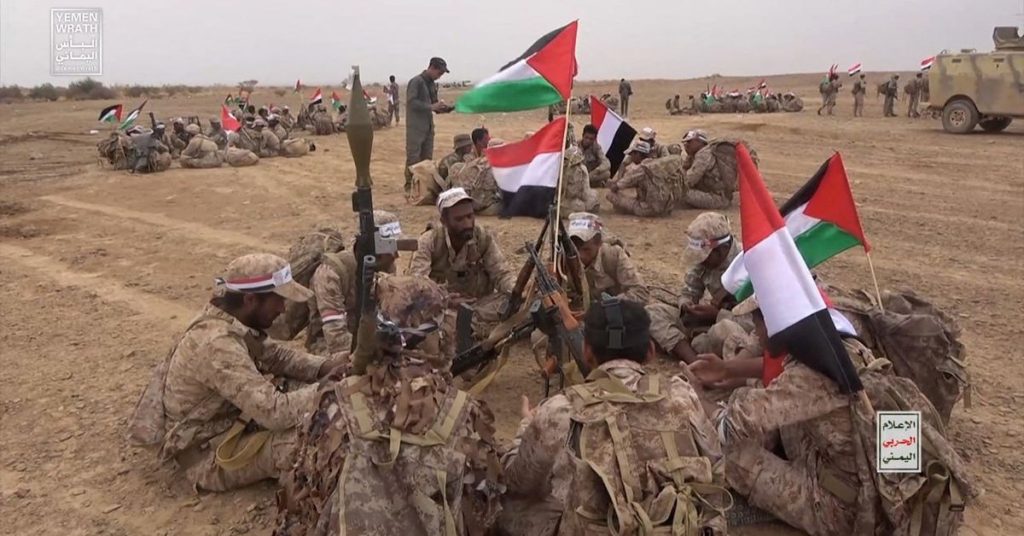DUBAI, Oct 31 (Reuters) – Yemen’s Houthis have waded into the Israel-Hamas war raging more than 1,000 miles from their seat of power in Sanaa, declaring on Tuesday they had fired drones and missiles at Israel in attacks that highlight the regional risks of the conflict.
Part of an “Axis of Resistance” backed by Iran, the Houthis have rallied behind the Palestinians since Hamas attacked Israel on Oct. 7, opening a new front for a movement that has waged war for eight years with a Saudi-led coalition in the Gulf.
Houthi military spokesperson Yahya Saree said in a televised statement the group had launched a “large number” of ballistic missiles and drones towards Israel, and there would be more such attacks to come “to help the Palestinians to victory”.
His statement confirmed the widening scope of a conflict that has unnerved states including the world’s biggest oil exporter Saudi Arabia, hardening fears of spillover as Israel seeks to destroy Hamas in its Gaza Strip stronghold.
Saree said it was the Houthis’ third attack on Israel since the start of the conflict, appearing to confirm they were behind a drone attack on Oct. 28 that resulted in blasts in Egypt and was blamed by Israel on the Houthis, and an Oct. 19 incident in which the U.S. navy intercepted three cruise missiles.
Israeli National Security Adviser Tzachi Hanegbi said the Houthi attacks were intolerable, but declined to elaborate when asked how Israel might respond.
The Houthis’ slogan is “Death to America, death to Israel, curse the Jews and victory to Islam”.
RESISTANCE AXIS
The Houthis are a formidable part of the “Axis of Resistance”, which opposes Israel and the United States and has been waging attacks across the region since Oct. 7.
Iran-backed Iraqi militias have been firing at U.S. forces in Iraq and Syria, while Lebanon’s Hezbollah has been exchanging fire with Israeli forces at the Lebanese-Israeli border.
The Houthis have demonstrated their missile and drone capabilities during the Yemen war in attacks on Saudi Arabia and the United Arab Emirates. The Saudi-led coalition accuses Iran of arming, training and funding the Houthis. The group denies being an Iranian proxy and says its develops its own weapons.
The United States, Israel’s main ally, has deployed aircraft carriers as a deterrent to prevent the Gaza conflict spreading. Iran has also said it does not want the war to spread.
But Iranian Foreign Minister Hossein Amirabdollahian on Tuesday indicated Tehran’s allies could act further.

Houthi fighters gather during a military manoeuvre near Sanaa, Yemen, October 30, 2023. Houthi Media Center/Handout via REUTERS/File photo Acquire Licensing Rights
“Resistance groups will not remain silent in the face of the Zionist regime’s crimes and America’s full support for the Zionist regime,” he said. “They won’t wait for anyone’s advice; if the situation gets out of control, no party will be safe from its consequences,” he said at a meeting with the Emir of Qatar, Iranian state media reported.
Houthi spokesperson Saree blamed Israel for instability in the Middle East, saying the “circle of conflict” in the region was being expanded by its “continued crimes”. The Houthis would continue to mount attacks “until the Israeli aggression stops”.
Noting that Houthi missiles and drones had been shot down during the latest hostilities, Mohanad Hage Ali of the Carnegie Middle East Center said for now their attacks were “more about messaging than a real military threat”.
“The risk to Israel would be if there is an all-out engagement, with multiple rocket launches from all directions which could overwhelm the air defences,” he said.
SAUDI CONCERNS
Yemen has enjoyed more than a year of relative calm amid a U.N.-led peace push. Saudi Arabia has been holding talks with the Houthis in a bid to exit the war, as Riyadh focuses on economic priorities at home.
But Houthi missile and drone attacks on Israel have increased the risks of conflict for Saudi Arabia.
The most direct flight path for any drone or missile launched from Yemen passes over western Saudi Arabia near the Red Sea before flying over Jordan and into Israel.
The Saudi government communications office did not respond to a request for comment on the kingdom’s concerns over Houthi attacks.
Saudi analyst Aziz Alghashian said Saudi Arabia would be worried about the conflict spilling across its own borders.
“I think the problem is that this war has the potential to put Saudi in a position where it is seen to take sides between the U.S. and Israel, and Iran,” he said. “I think Saudi wants to avoid that.”
Saudi Arabia and Iran, respectively the region’s leading Sunni Arab and Shi’ite powers, agreed to restore diplomatic ties earlier this year, easing years of tensions that have fuelled conflicts across the Middle East.
In 2019, the Houthis claimed responsibility for an attack that temporarily cut more than half of Saudi oil output. The United States said Iran was behind the attack, which Tehran denied.
Additional reporting by Nadine Awadalla and Nayera Abdallah in Dubai, by Tom Perry in Beirut, Parisa Hafezi in Dubai, Henriette Chacar and Ari Rabinovitch in Jerusalem, and by Mohamed Ghobari in Aden, Writing by Tom Perry; Editing by Angus MacSwan and Gareth Jones
Our Standards: The Thomson Reuters Trust Principles.

